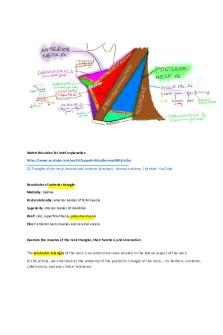XLDA EXAM PREP - PDF

| Title | XLDA EXAM PREP - |
|---|---|
| Course | Marketing Research |
| Institution | British Columbia Institute of Technology |
| Pages | 2 |
| File Size | 56.2 KB |
| File Type | |
| Total Downloads | 3 |
| Total Views | 145 |
Summary
2020...
Description
XLDA EXAM – Labs 9, 10 and lecture 9.2 – 10% Calculating Sample size 1. Add-ins calculate sample size 2. If asked maximum variability its 50 3. Look at the 95% confidence column for the answer in bold 4. Allow about error 3 for worst Multiple Response: Summary Table 1. Only focus on the checked responses or Yes or in red 2. Manually transfer the numbers into the MR table 3. Frequency Number of people checked Auto sum 4. Drop the total into total sample size 5. PCT of answers divide respondents by answers Non-metric/Metric: Percent – Segments 1. Add-ins Summarize Precents Can do for a metric and non-metric question 2. Non-Metric: Question about how many people would be concerned 3. Metric How many people Single Metric: Average – Relative Ratings 1. Add-ins Summarize Averages 2. Look at the average with the highest number 3. For standard deviation: Larger the number the more variable the response it Grid, Identify Segments: Precents 1. Add-ins Summarize Precents Select all that apply 2. Run a profile on segments Grid: Relative Rating: Averages 1. Add-ins Summarize Averages Select all that apply 2. Run a profile on segments Profile Segments: Crosstabs 1. Add-ins Relate Crosstabs Select Column and Row Variable 2. Run a profile on segments 3. Column Goes in the type of people that people are interested in Column are always demographic questions (Age, Gender, etc. are demographic traits) Type of person always goes in column 4. Sig is less than or equal to 0.5 means there is a significant difference between males and females on how they respodanted to this question 5. Always looking for percentages Look for the largest difference in male to female
Identify problems with charts – Lecture 9.2 Common Problem’s with charts: Bar Chart -
Decimal places Legend Percent Scale Title – Not descriptive Axis Labels Sample Size -- Bottom left-hand corner
Average 1. 2. 3. 4. 5.
Needs to start at 1 Rating scale (what is 1, 2 ect) Sample size Title – Not descriptive Data Labels on each bar
Bar Chart – Comparing Charts 1. The scale is not the same (y axis has to end at the same point) – Unethical visual – 2. CONSTISTANCY 3. Can’t have different scales – 5 point scales...
Similar Free PDFs

XLDA EXAM PREP -
- 2 Pages

EXAM PREP 2020 - Exam prep
- 22 Pages

Exam Prep
- 21 Pages

Respiratory-Exam OSCE Exam Prep
- 2 Pages

Note 23 - exam prep
- 4 Pages

Exam Prep Notes
- 25 Pages

Midterm Exam Prep Sheet
- 4 Pages

PYSC B EXAM PREP
- 75 Pages

MCQ exam prep (10)
- 6 Pages

Final exam prep
- 8 Pages

Exam Prep - Agency
- 7 Pages

Exam Prep - Insolvency
- 11 Pages

MGF3681 Exam prep questions
- 2 Pages

Exam prep Worksheet one
- 14 Pages

Note 23 - exam prep
- 4 Pages

Exam Prep - Partnership
- 7 Pages
Popular Institutions
- Tinajero National High School - Annex
- Politeknik Caltex Riau
- Yokohama City University
- SGT University
- University of Al-Qadisiyah
- Divine Word College of Vigan
- Techniek College Rotterdam
- Universidade de Santiago
- Universiti Teknologi MARA Cawangan Johor Kampus Pasir Gudang
- Poltekkes Kemenkes Yogyakarta
- Baguio City National High School
- Colegio san marcos
- preparatoria uno
- Centro de Bachillerato Tecnológico Industrial y de Servicios No. 107
- Dalian Maritime University
- Quang Trung Secondary School
- Colegio Tecnológico en Informática
- Corporación Regional de Educación Superior
- Grupo CEDVA
- Dar Al Uloom University
- Centro de Estudios Preuniversitarios de la Universidad Nacional de Ingeniería
- 上智大学
- Aakash International School, Nuna Majara
- San Felipe Neri Catholic School
- Kang Chiao International School - New Taipei City
- Misamis Occidental National High School
- Institución Educativa Escuela Normal Juan Ladrilleros
- Kolehiyo ng Pantukan
- Batanes State College
- Instituto Continental
- Sekolah Menengah Kejuruan Kesehatan Kaltara (Tarakan)
- Colegio de La Inmaculada Concepcion - Cebu